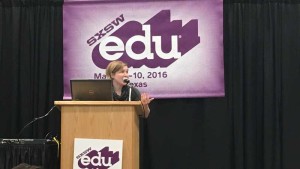 Are you an educator? Have you ever wanted to implement ideas in Education Technology? Candace Flaherty, from Mobility Labs Inc., strives to bring “teacher voice” into the design process for developing EdTech. In this panel, Flaherty explained how ed tech developers can incorporate “teacher voice,” or teacher input, into the design process. Mobility Labs Inc. collaborates with their clients, users and industry experts to produce digital products for social good and education. Mobility Labs Inc. was founded in the fall of 2011 by Sean Perkins who has now created a team of developers, designers, content strategists and educational experts.
Are you an educator? Have you ever wanted to implement ideas in Education Technology? Candace Flaherty, from Mobility Labs Inc., strives to bring “teacher voice” into the design process for developing EdTech. In this panel, Flaherty explained how ed tech developers can incorporate “teacher voice,” or teacher input, into the design process. Mobility Labs Inc. collaborates with their clients, users and industry experts to produce digital products for social good and education. Mobility Labs Inc. was founded in the fall of 2011 by Sean Perkins who has now created a team of developers, designers, content strategists and educational experts.
First, Flaherty brought up the big question. What exactly is user-centered design? User-centered design is a framework process in which the needs, the wants and limitations of end users of a product, service or process are given extensive attention at each stage of the design process. Technology has always been built by developers, but consumers who actually use a product and developers who create a product see and understand things differently. The design process for Mobility Labs includes teachers’ input throughout the entire process. There are several steps in the design process to incorporate teacher voice.
- Research. In terms of research in this perspective, this could be discussing things with clients, doing class observations and surveys. The goal here is to learn as much about not only the product, but the user as well.
- Discovery. Flaherty says this part is a ton of fun. Everyone in the group creates sketches of a product that reflect on their own ideas. Then the groups turn these sketches into low-fidelity wireframes.
- Refine. After the building process, they receive feedback from teachers. They then adjust the product to the teacher’s feedback. For example, when teachers were looking for something in the product and couldn’t find it, they refined the product to where the teachers would think it would be.
- Launch. Continuous feedback through each step is important so they can figure out what to do in the next versions of the product.
So what can companies can do to get feedback from teachers? Teachers are very busy as is, so companies need to work with their schedule in order to get the teacher voice involved in EdTech products. Before the feedback sessions, companies need to do some research on district rules. Next: plan ahead. During certain parts of the semester a teacher could be more busy than usual so it’s important to plan in advance for a good time that works for them. Of course, you need to be flexible with the teacher and keep it short. Flaherty also mentioned to always say ‘thank you’ and be appreciative for the teachers taking the time out of their day to help refine an EdTech product. Teacher feedback sessions can take form in focus groups, phone, Skype or in-person interviews during the design and development process.
"'I have tons of free time' said no teacher ever." Candace @MobilityLabs about getting teachers involved in testing ideas. #futureofschool
— Alli Lee (@AlliMLee) March 8, 2016
Technology has an important role to play in supporting teachers, education leaders and students. By involving teachers as co-designers, EdTech companies can ensure that education products both meet real needs and are enjoyable to use.
